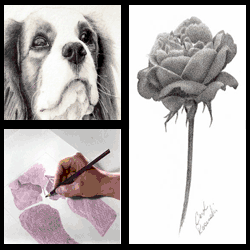Here are some general advices on learning to draw:
Choosing Paper
I suggest using a good rag (100% cotton) or a wood based paper that has been buffered. Any other type of paper will yellow in a very short time. I've written reviews of some the paper I've tried that might help you make a choice.
Choosing Paper
I suggest using a good rag (100% cotton) or a wood based paper that has been buffered. Any other type of paper will yellow in a very short time. I've written reviews of some the paper I've tried that might help you make a choice.
Drawing from Photo References
There are two things about photography that I'd like to share with you. If you want to capture natural lighting, turn off your flash. If the light is very dim, use a tripod to reduce blur. I never use a flash because it's always the beautiful natural lighting that attracts me to a scene. The other thing that I suggest is taking lots of photos of your subject using different focus points if possible. I do this as often as I can so I won't be stuck with only the focus the camera lens has given me.
There are two things about photography that I'd like to share with you. If you want to capture natural lighting, turn off your flash. If the light is very dim, use a tripod to reduce blur. I never use a flash because it's always the beautiful natural lighting that attracts me to a scene. The other thing that I suggest is taking lots of photos of your subject using different focus points if possible. I do this as often as I can so I won't be stuck with only the focus the camera lens has given me.

Understanding Perspective
Perspective gives so many people trouble because of psychology, I think. We tend to make the things that are interesting or important to us larger when we're drawing them. What really helped me learn to see perspective, and to understand how to draw what I was seeing, was to draw on a window. I would look through a window and trace what I saw with a wax pencil. Something about running a pencil tip over the lines of objects helped me to understand perspective in an intuitive way. This exercise may help you too.
Learning to control your tools
Half the battle of learning to draw is being able to make your pencil draw what your eye sees. I have written three lessons intended to teach tool control:
Draw a Smoothie
Draw a Graduation
How to Make and Use Powdered Graphite
Last Thoughts
Ice, Fur and Other Details
Don't let any subject frighten you. All subjects can be broken down into values if you just take the time to really look at them. Ice, skin, fur, hard and soft textures ... they all can be drawn if you think of them as values.
Don't worry, just practice...
Perspective gives so many people trouble because of psychology, I think. We tend to make the things that are interesting or important to us larger when we're drawing them. What really helped me learn to see perspective, and to understand how to draw what I was seeing, was to draw on a window. I would look through a window and trace what I saw with a wax pencil. Something about running a pencil tip over the lines of objects helped me to understand perspective in an intuitive way. This exercise may help you too.
Learning to control your tools
Half the battle of learning to draw is being able to make your pencil draw what your eye sees. I have written three lessons intended to teach tool control:
Draw a Smoothie
Draw a Graduation
How to Make and Use Powdered Graphite
Last Thoughts
Ice, Fur and Other Details
Don't let any subject frighten you. All subjects can be broken down into values if you just take the time to really look at them. Ice, skin, fur, hard and soft textures ... they all can be drawn if you think of them as values.
Don't worry, just practice...


This is a comment.
ReplyDeleteallooooo....
ReplyDelete